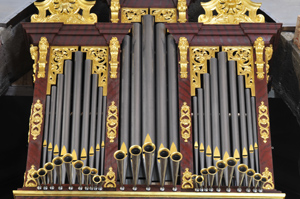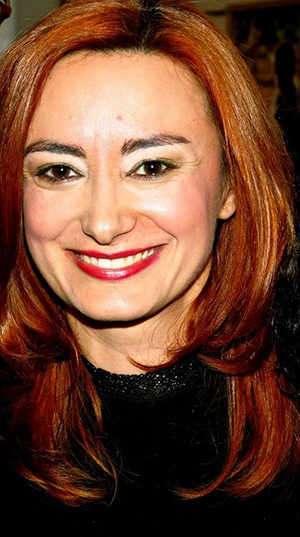
Wednesday 22 October, 9.30, p.m.
Hospice of Bom JesusJoão Paulo Janeiro, organ
João Paulo Janeiro, organ
Paula Erra, declamation
A programme that seeks to bring together music and literature can at the same time be a rewarding challenge and difficult to bring off in the context of a concert, especially when we are talking about a solo organ recital. However, taking into account the preparation of a programme dedicated to the oldest organ repertory, especially in terms of Portuguese and Iberian music, the connections between the art of making music and that of the literary gloss are extremely various, from the use of vocal repertoire by organists, which may be seen in the collections of music in which intabulations of organ pieces predominate, to the double role of poet and musician that some of the figures of Iberian humanism took on, such as Juan del Encina, Gil Vicente and Damião de Góis. Thus, in an attempt to reflect to some extent this creative duality, this concert programme includes music and the “gaia scienza” of some authors, or the technical capacity and creative freedom of literature, unfold mutually, in parallel, in themes that may or may not be related, allowing dialogue between organist and recited text. Both music and literature are from the 15th and 16th centuries. They include different genres and forms in an attempt to illustrate some important examples of both disciplines, making occasional reference to significant moments in Portuguese history
We begin with a text by Juan del Encina which seeks to differentiate between creator and performer, separating them on Boetian lines – a polemic that would continue beyond the 16th century in various ways – and in parallel the hymn to St Bernard, Exultat celi curia. The chronicles of Santa Cruz from which comes the text entitled Dom Affonso e o Cardeal de Roma go back to the origins of Portugal and portray the founding ing as someone wild and irreverent, but concerned with the future of the country that he founded. Paired with this text is the intabulation for organ of a vocal work attributed to Gullaume Dufay, La Portugaler, found in the most famous keyboard anthology of the 15th century, the Buxheimer Orgelbuch.
From the Cancioneiro Geral of Garcia de Resende published in Lisvon in 1516 we have taken the famous song by Jorge Roiz de Castelo-Branco, most recently sung by the fado singer Amália Rodrigues to music by Alain Oulman, but which in this recital pairs another intabulation from the oldest printed collection of Iberian music for keyboard by Gonçalo de Baena. The vocal piece, the motet Clamabat autem mulier by Pedro de Escobar, appeared in various collections of music for keyboard and plucked strings. Of Dom Manuel de Portugal, Count of Vimioso, it is known that he wrote above all mystical poetry, almost all in Spanish, but also a Treatise on Prayer in Portuguese. A nobleman concerned in the defence of patriotic ideals, according to some writers a kind of Portuguese Thomas More, he was a contemporary of the famous Carreira family of musicians, chapelmasters and composers of keyboard music who decisively affected the development of the Tento and its performance. The Sonnet by Dom Manuel is dedicated to the memory of another important Portuguese poet: Sá de Miranda.
On 19 April 1506, an appalling event took place in Lisbon, the killing of all Jews and New Christians. Damião de Góis describes it in detailed fashion in his royal chronicle. Though it was not unique, this event was decisive in the exodus from Portugal of the Jewish community, the implications for the development of the history of the country. In parallel with this text we perform the Tento do 4.º Tom by Heliodoro de Paiva. To conclude this programme there is an excerpt from Gil Vicente, considered the co-founder of Iberian theatre, together with Juan del Encina. The excerpt is a speech by the Soul from the Auto da Alma, which curiously begins in the same way the Cântico Negro by José Régio, but which here makes his penitence asking for help after confronting his mixed nature, divine and erring, or emulating the ideas of Erasmus and the Roman Church. The Differencias by Antonio de Cabezón are a remarkable example of the widely admired practice of composing variations on the songs and melodies in fashion at the time.
João Paulo Janeiro
Juan del Encina (1469-1529)
De la diferencia que hay entre poeta y trobador
(Cancionero de toda las obras, 1496)
Anonymous
Hino a São Bernardo Exultat celi curia
(Manuscrito Musical do Convento de Arouca, séc. XV)
Anonymous
Dom Afonso e o Cardeal de Roma
(Crónicas Breves de Santa Cruz, séc. XV)
Anonymous
Portugaler
(Das Buxheimer Orgelbuch, M. Mus. 3725 da Biblioteca Estatal de Munique)
Jorge Roiz de Castelo-Branco (14??-1515)
Partindo-se
(Cancioneiro Geral de Garcia de Resende, Lisboa, 1516)
Pero do Porto [Pedro de Escobar] (1465-1535)
Clamabat autem mulier
(Gonçalo de Baena, Arte de Tanger, 1520)
D. Manuel de Portugal (1516-1606)
Soneto em memória de Sá de Miranda
(Obras de Don Manoel de Portugal, 1605)
António Carreira (ca.1525/30-ca.1589/97)
Canção
(M. Mus. 242 da Biblioteca Universidade Coimbra)
Damião de Góis (1502-1574)
O Pogrom de Lisboa de 1509
(Crónica do Felicissimo Rei Dom Manuel, 1566-67)
Heliodoro de Paiva (1502-1552)
Tento do 4.º Tom
(M. Mus. 242 Biblioteca da Universidade de Coimbra)
Gil Vicente (1465-1536?)
Auto da Alma (1518) (excerto / excerpt)
Antonio de Cabezón (1510-1566)
Diferencias sobre la Gallarda Milaneza
Participants
|
A performer on historical keyboard instruments, João Paulo Janeiro divides his professional activity between research, concerts, recordings and teaching. He studied in Lisbon, specializing in harpsichord, organ, clavichord and historical musicology. He directs the ensembles Flores de Mvsica, Capella Joanina and Concerto Ibérico - Orquestra Barroca, with which he has actively promulgated the musical heritage of Portugal. He has worked with the most important orchestras in Portugal and abroad in concerts and recordings. He has recorded various CDs on organs and other historical keyboard instruments from the Museum of Music in Lisbon, and has recorded a number of CDs and radio and television programmes devoted to Portuguese music. He is responsible for the publication of critical editions of the Sonatas and Duets by João Baptista Avondano and for the project of publishing the complete works of Francisco António de Almeida with MAACedita, having prepared the scores of the Grande Missa em Fá and the Te Deum. He is currently preparing editions of the first Portuguese opera, La Pazienza di Socrate and of the opening versicle of vespers, Domine ad Adjuvandum me Festina, for soloists, choir and orchestra. He devised and directs the ‘West Coast Early Music Festival’, ‘Ciclo de Teclas Fim da Tarde’, ‘Série Ibérica de Música Antiga’ and the ‘Jornadas de Órgão do Alentejo’. He completed an inventory of the historical organs of the Alentejo for the Regional Department of Culture, and has supervised restorations in the region. He devised and directs the International Courses of Early Music and the International Competition for Young Performers of Early Music. He teaches organ, harpsichord, chamber musc and basso continuo and classes in historical performances at ESART-IPCB and at EMNSC. He has taught and given concerts in Italy, and given masterclasses in harpsichord, basso continuo and baroque orchestra. He is president of the MAAC, a member of CESEM (FCSH-UNL) and of the Portuguese Society for Research in Music (SPIM). He has given paper and published articles in the field of organology and Portuguese baroque music. He is completing a doctorate in musicology on the practice of the basso continuo in Portugal in the 17th century. |
|
Actress, theatre trainer and art-therapist, Paula Erra was born in Funchal in 1973. She began her studies in theatre in 1989 at the Experimental Theatre of Funchal. She completed the first, second and third courses for directors/producers and actors promoted by the theatre section of Inatel. In the productions in which she has taken part, as well as acting, she has assisted with the staging, dramaturgy and vocal direction of actors. She graduated in education sciences, and did post-graduate work in art therapy. She founded the Theatre Group of the University of Madeira (later called Academic Theatrical Laboratory). She created and directed the discipline of dramatic education at the Prison Establishment of Funchal and the Centre for Treatment of Addiction (Santiago Health Centre). She was vice president of the Artistic Association of Education through Art in Madeira, where she taught creative exploration, voice and interpretation, and directed actors in her artistic area. She wrote, with Avelina Macedo, the play Um Outro Caminho. She created and organized with Celina Pereira the performed readings project Céu&Palavras. She has worked with the producers Eduardo Luiz, Mário Feliciano, Fernando Augusto and Carlos Cabral, amongst others. She recently created, with Élvio Camacho, the Teatro Feiticeiro do Norte. |
Notes about the Organ
 Hospice of Bom Jesus, Funchal
Hospice of Bom Jesus, Funchal
This small positive organ was built in 1781 by Leandro José da Cunha (b. 1743, d. after 1805), who was from Lisbon and was one of the three members identified as belonging to this family of organ builders. Leandro was the son of the builder João da Cunha (b. 1712, d.1762), also from Lisbon, who built the organ of the Church of Nossa Senhora da Luz, at Ponta do Sol.
It is an example of a type of instrument typical of Portuguese organs in the first half of the 18th century. The fact that the instrument did not originally possess a basic 8’ (12-palm) stop – like many other positives of the period – but only 4’ (6-palm), seems to indicate a musical practice that relied on reinforcement in the lower register through the use of another instrument.
Manual (C, D, E, F, G, A-d’’’)
Flautado de 6 tapado (4’)
Quinzena (2’)
Dezanovena (1 1/3’)
22ª e 26ª
Sesquialtera II ( )
 João Paulo Janeiro
João Paulo Janeiro Paula Erra
Paula Erra